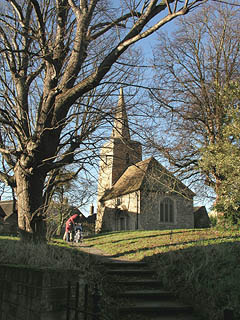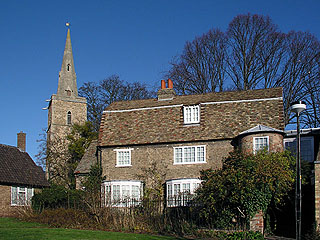 |
St Peter sits in a very ancient religious site. The old Roman town at Cambridge was on the north side of the river, and I've heard suggestions (though I couldn't find any evidence when I came to write this entry) that this little mound on the edge of the Roman road leading out towards Huntingdon was the site of a temple of Diana. Whatever the truth of that, we know that there was a church of St Peter here from at least the 11th century. All that remains of that building is a blocked-up doorway in the north wall, and the church has been reconstructed various times since. The south doorway survives from a 13th century building, and the bottom part of the tower is 14th century, but most of the rest comes from 1781, when the church was almost entirely pulled down and reconstructed (using many of the same materials, mind you) on a much smaller scale. Dwindling congregations are a problem for all of the Cambridge churches, but St Peter (whose parish shrank very considerably after the Reformation) has had to cope with it for much longer. They eventually gave up the long fight in 1971, when the church was made redundant and passed to the Churches Conservation Trust, who are doing a characteristically good job of looking after it.
From the outside, it is a jewel of a church. The churchyard is hemmed in on the north and west by housing, and on the south by the excellent Kettle's Yard art gallery, so most first glimpses of St Peter are of the tower rising above other buildings. It is a simple structure - no buttresses, and four little stages separated by plain sills. The spire on top probably dates from the 18th century rebuilding.
The churchyard rises sharply from the road, and is filled with fine mature trees, so when one enters from the south-east corner, the church itself is almost hidden. It gradually reveals itself as one walks along the path - a tiny structure built of brick and sandy-coloured stone rubble. Some medieval windows survive, but the only really eye-catching exterior feature is the south doorway. This is supposed to date from the thirteenth century, but if it does, the builders constructed it in a surprisingly archaic fashion - it has a large round Norman arch over the top, with typically Norman engaged shafts and nailhead moulding in the jambs. It has been very badly treated by time, alas; the moulding has been eroded almost to nothing, and one of the decorative shafts has been replaced by a rough wooden pillar at some point - but it is still rather nice.
 |
The interior is every bit as plain and severe as one would expect from a CCT church. The south doorway opens straight into a single cell, the only other space being the area under the tower. The floor is composed of slightly bumpy flagstones, with a single step at the east end to indicate the sanctuary. The roof is a rather utilitarian wooden affair and, like the walls, is painted white. There is almost nothing to comment on, save that the simplicity doesn't feel at all cold or stark on this small scale. When St Peter's is open it is often filled with visitors, but if you catch it by itself on a sunny day, with light streaming in through the few rescued ancient windows, it can feel like much the holiest place in the city.
A few monuments survive scattered around the church. Two, set into the south-west edge of the tower arch, are from the older building. The third is in the floor to the south of the altar, and commemorates Jim Ede. Ede was the artist who created Kettle's Yard, which is much the loveliest art gallery in Cambridge. The best bit of it is his house, which is preserved as it was when he lived there, filled with paintings by his St Ives colleagues like Ben Nicholson, and by more impromptu collections of pebbles, shells and bottles. There is also an attached gallery which is host to a series of visiting exhibitions, some of which are really quite good. Ede (who died in 1990 at the age of 95) helped to save St Peter when the structure was in danger of collapsing entirely, and it is lovely that he is commemorated here.
I've saved the best bit of St Peter till last, though. This is the amazing font, which (along with the north doorway I mentioned earlier) survives from the original Norman church. The top is just a rough square block with a round bowl set into it. Around the edges, though, are carved four mermaids. They sit on the corner, clasping their bifurcated tails in their hands (yes, medieval mermaids had two tails), with their long twisted braids merging to form a barleytwist border along the top edge. The carving is a bit crude, and most of their faces have been eroded away to nothing, but it is still a splendid and rather pagan thing. It's almost unique, too - the only other one we've ever found is at Anstey, far to the south in Hertfordshire.
St Peter is often open, and a key can be borrowed from Kettle's Yard when it isn't.